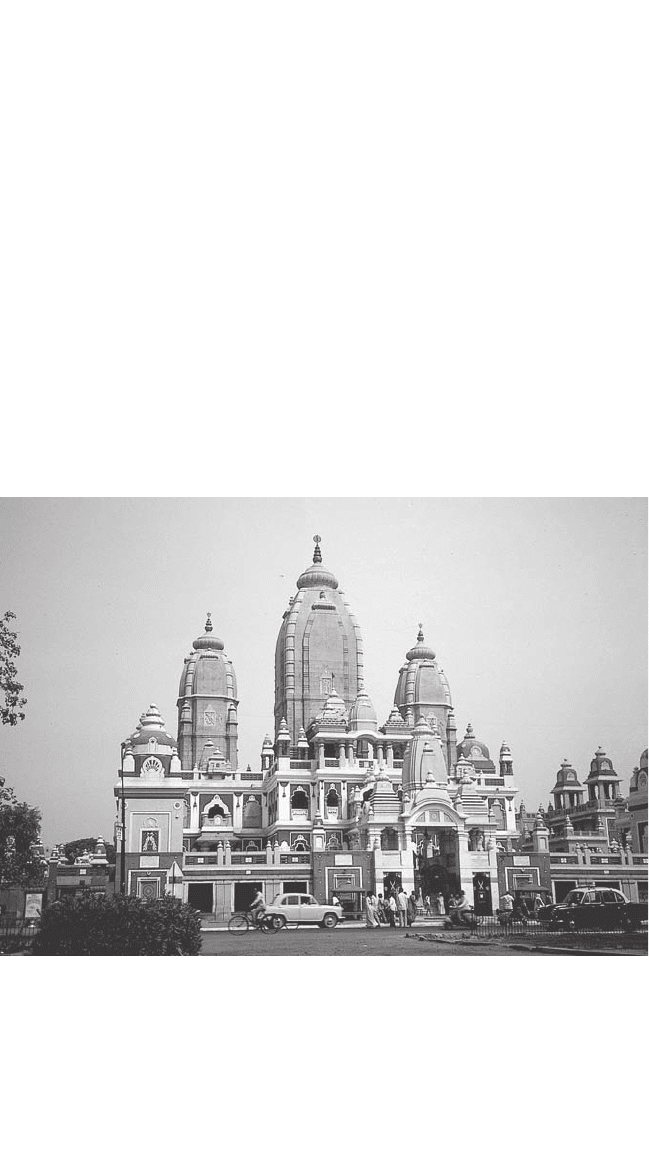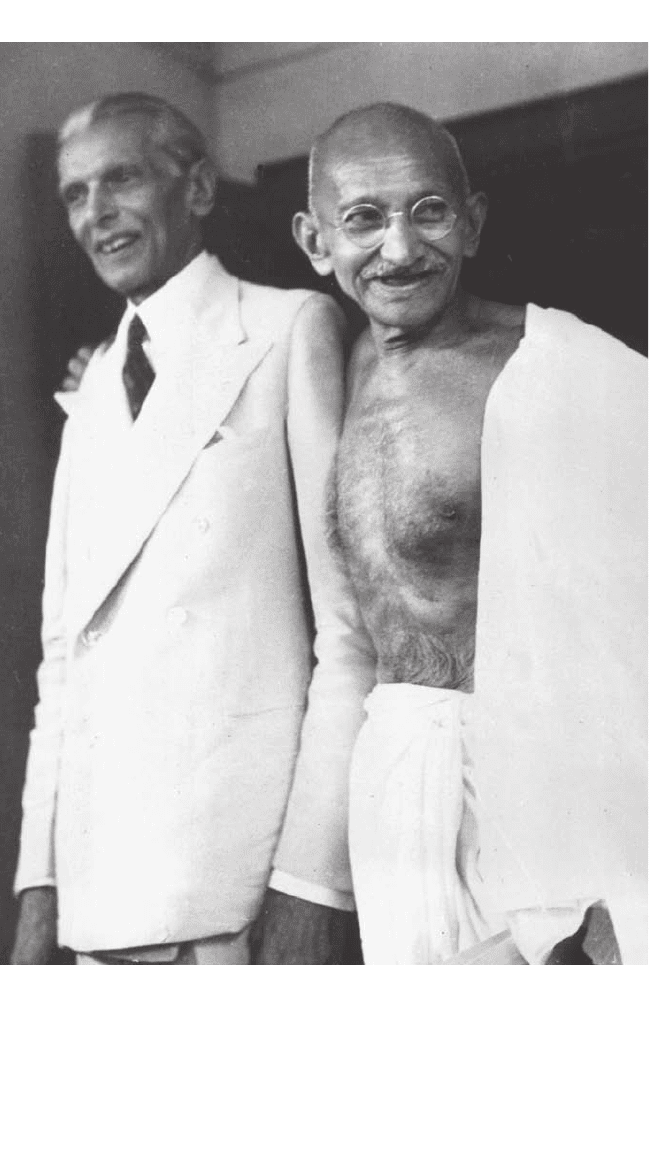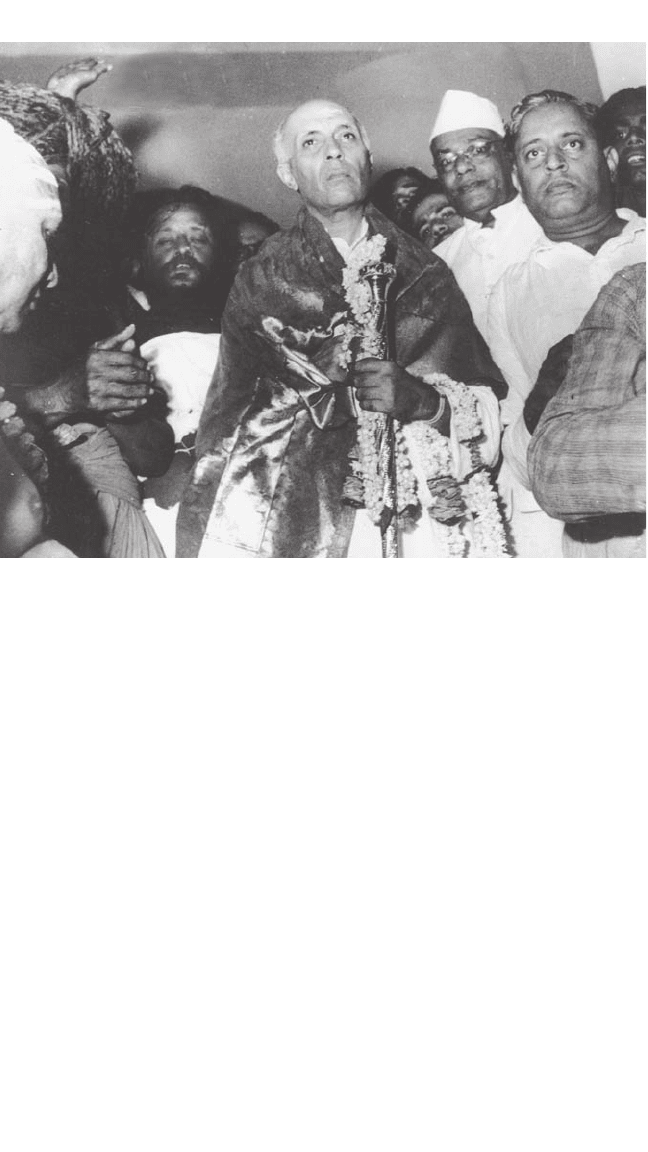Walsh J.E. A Brief History of India
Подождите немного. Документ загружается.


A BRIEF HISTORY OF INDIA
212
of India made up of 11 provinces, all the princely states, and a small
number of territories. The provinces were to be run by elected Indians
and the princely states by the princes. At the act’s center was the “steel
frame” that would preserve British control over India: The viceroy and
his administration remained in control of the central government with
a separate, protected budget and authority over defense and exter-
nal affairs (Jalal 1985, 17). Two central legislative houses were also
included in the act but never functioned, rejected for different reasons
by both the princes and the Congress. Provincial autonomy, however,
began in 1937 after nationwide elections that enfranchised 35 million
Indians (about one-sixth of India’s adult population).
Congress in Power
The Congress Party swept the provincial elections of 1937, winning 70
percent of the total popular vote and the right to form governments in
Birla Mandir, New Delhi. The Lakshmi Narayan Temple (commonly known as the Birla
Mandir, or “temple”) was built by the industrialist B. D. Birla in the late 1930s. The Birlas
were major fi nancial supporters of Mohandas Gandhi, and Gandhi himself dedicated the
temple at its opening in 1938. The ornate, pink-colored temple was dedicated to Vishnu
(Narayan) and his wife Lakshmi. Among the marble designs on its inside are panels illustrat-
ing the Bhagavad Gita.
(courtesy of Judith E. Walsh)
001-334_BH India.indd 212 11/16/10 12:42 PM

213
GANDHI AND THE NATIONALIST MOVEMENT
eight out of 11 provinces: Madras, Bombay, Central Provinces, Bihar,
United Provinces, Northwest Frontier, Orissa, and Assam. Regional
parties won control of three out of the four Muslim majority provinces:
Bengal, Punjab, and Sind. (Congress had won the fourth, the Northwest
Frontier.) The Muslim League, in contrast, won only 5 percent of the
total Muslim vote—109 seats out of 482 Muslim contests—and none of
the Muslim majority provinces.
In their provincial governments and coalitions, winning Congress
politicians made few concessions either to Muslim representatives or
to Muslim sensibilities. In the United Provinces, Congress offi cials
told Muslim League representatives that they could participate in the
government only if they left the league and joined the Congress Party.
Congress-dominated provincial assemblies sang “Bande Mataram,” and
regional Congress discourse extolled the virtues of the cow, the Hindi
language, and the Devanagari script. For Jinnah, working later in the
1940s to rebuild the Muslim League, Congress provincial governments
provided a clear illustration of the dangers Islam and Indian Muslims
would face in an India ruled by a Hindu-dominated party.
On the national level, Gandhi and the Congress “old guard” faced a
challenge from the party’s left wing. In 1938 Subhas Bose won election
as Congress president, supported by leftist and socialist Congress mem-
bers. He was opposed by Gandhi, Congress businessmen, and more
moderate Congress politicians. Bose and Gandhi had been opponents
within the Congress, disagreeing on economic policies and political
tactics. Unlike Nehru, however, Bose was unwilling to yield to Gandhi’s
overall leadership. Gandhi tolerated Bose as Congress president for
the fi rst term, but when Bose narrowly won reelection the following
year, Gandhi engineered the resignations of most Working Committee
members. Bose worked alone for six months before giving up and
resigning the presidency. He and his brother Sarat resigned also from
the Congress Working Committee and returned to Bengal to form their
own party, the Forward Block, a left-wing coalition group.
Pakistan
After the losses of the 1937 election, Jinnah had to rebuild the Muslim
League on a more popular basis. To do so, by the 1940s he was advo-
cating the idea of “Pakistan” and stressing the theme of an Islamic
religion in danger. At the 1940 Lahore meeting of the Muslim League,
Jinnah declared—and the League agreed—that Muslims must have
an autonomous state. “No constitutional plan would be workable in
001-334_BH India.indd 213 11/16/10 12:42 PM

A BRIEF HISTORY OF INDIA
214
this country or acceptable to the Muslims,” the League stated in its
1940 Lahore Resolution, unless it stipulated that “the areas in which
the Muslims are numerically in a majority . . . should be grouped to
constitute ‘Independent States’ in which the constituent units shall be
autonomous and sovereign” (Hay 1988, 228). The idea of a separate
Islamic Indian state had been expressed 10 years earlier by the Urdu
poet Muhammad Iqbal (1877–1938). The imagined state had even been
given a name by a Muslim student at Cambridge in 1933: He called it
“Pakistan,” a pun that meant “pure land” and was also an acronym for
the major regions of the Muslim north (P stood for the Punjab, a for
Afghanistan, k for Kashmir, s for Sindh, and tan for Baluchistan).
The diffi culty with the idea of Pakistan was that it did not address
the political needs of most Indian Muslims. Most Muslims were scat-
tered throughout India in regions far from the four northern Muslim
majority provinces. Minority Muslim populations needed constitu-
tional safeguards within provincial and central governments, not a
Muslim state hundreds, even thousands, of miles from their homes.
Jinnah himself had worked throughout his career to establish just
such safeguards within a strong centralized government. Some schol-
ars have suggested that his support for Pakistan in the 1940s began
as a political tactic—a device to drum up Muslim support for a more
popularly based Muslim League and a threat to force concessions from
Congress leaders, particularly from Gandhi for whom the idea of a
divided India was anathema.
The idea of a state ruled by Islamic law where Muslim culture
and life ways could reach full expression had great appeal to Indian
Muslims. Muslims in majority regions imagined Pakistan as their own
province, now transformed into an autonomous Muslim state. Muslims
in minority provinces (always Jinnah’s strongest constituency) thought
of Pakistan less as a territorial goal than as a political identity—a
Muslim national identity—that would entitle Indian Muslims to a pro-
tected position within any central Indian government. Even as late as
1946–47, Muslims in minority provinces supported the idea of Pakistan
with little sense of what it might mean in reality. As one Muslim, a stu-
dent in the United Provinces at that time, later recalled,
Nobody thought in terms of migration in those days: [the
Muslims] all thought that everything would remain the same,
Punjab would remain Punjab, Sindh would remain Sindh, there
won’t be any demographic changes—no drastic changes any-
way—the Hindus and Sikhs would continue to live in Pakistan
. . . and we would continue to live in India. (Pandey 2001, 26)
001-334_BH India.indd 214 11/16/10 12:42 PM

215
GANDHI AND THE NATIONALIST MOVEMENT
Quit India!
On September 3, 1939, the viceroy, Victor Alexander John Hope, Lord
Linlithgow (1887–1952), on orders from Britain, declared India at
war with Germany. This time, however, the Indian National Congress
offered cooperation in the war only on condition of the immediate
sharing of power in India’s central government. In April 1942, in an
attempt to win over Congress leaders, the British government fl ew Sir
Stafford Cripps (a personal friend of Nehru’s) to India. With British
prime minister Churchill completely opposed to any concessions to
Indian independence, even as a possible Japanese invasion loomed on
India’s eastern borders, Cripps offered Congress leaders only a guar-
antee of dominion status (a self-governing nation within the British
Commonwealth) at the end of the war. Gandhi called Cripps’s offer “a
post dated cheque” (Brecher 1961, 109).
With Cripps’s mission a failure, Gandhi and the Congress opened a
new civil disobedience campaign: “Quit India!” The government imme-
diately imprisoned all major Congress leaders. Nevertheless, an unco-
ordinated but massive uprising spread throughout the country leading
to more than 90,000 arrests by the end of 1943. Protests were marked
by sporadic violence and included attacks on railways, telegraphs, and
army facilities. The British responded with police shootings, public
fl oggings, the destruction of entire villages, and, in eastern Bengal, by
aerial machine-gun attacks on protesters.
Beginning in 1942 and lasting through 1946 a terrible famine erupted
in Bengal. The famine was caused not by bad weather but by the con-
junction of several other factors: the commandeering of local foods to
feed the British army, the wartime stoppage of rice imports from Burma,
profi teering and speculation in rice, and perhaps also a rice disease that
reduced crop yields. By 1943 tens of thousands of people had migrated
into Calcutta in search of food and an estimated 1 million to 3 million
people had died from famine-related causes.
Independence
At the end of World War II, with a new Labor government in place,
huge war debts to repay, and a country to rebuild, the British wanted to
exit India. The combined costs of war supplies and of an Indian army
mobilized at 10 times its normal strength had more than liquidated
India’s debt to Great Britain. Instead of home charges, it was now Great
Britain that was in debt to India. British offi cials in both London and
New Delhi knew Britain could no longer maintain its empire in India.
001-334_BH India.indd 215 11/16/10 12:42 PM

A BRIEF HISTORY OF INDIA
216
The biggest obstacle to British withdrawal, however, was the politicized
communal identities that had grown up over the 20th century, fostered by
Indian nationalists and politicians and by the British themselves through
their “divide and rule” tactics. Such identities divided Muslims and
Hindus, but they also existed among Sikhs, South Indian “Dravidians,”
and Untouchables. The problem was how to reunite all these political
groups within the majoritarian electoral structures of a modern demo-
cratic state, while simultaneously protecting their minority interests.
The Congress Party won 91 percent of all non-Muslim seats in
the winter elections of 1945–46 and was returned to power in eight
provinces. By the 1940s Congress had built an all-India organization
with deep roots throughout the country and with a unity and identity
developed over its more than 50 years of struggle against British rule.
The party’s goal was a strong, centralized India under its control. For
Congress socialists, like Nehru, such centralization would be essen-
tial if India was to be rebuilt as an industrialized, prosperous state.
Minority groups’ fears over such centralization, meanwhile, were an
irritant for Congress. From the Congress perspective political differ-
ences between Hindus and Muslims could wait for resolution until
after independence.
BOSE’S INDIAN
NATIONAL ARMY
I
n 1941 Subhas Bose’s arrest for sedition was imminent in Calcutta,
and he fl ed India, seeking sanctuary with the Nazi government in
Germany. In 1942 he was taken to Japan by the Germans and then to
Singapore, now under Japanese control. In Singapore, Bose formed
the Indian National Army (INA), drawing his recruits from the 40,000
Indian prisoners of war interned in Japanese camps. His new army
fought with the Japanese against the British in Burma.
Many Indians identifi ed with the INA and saw it as a legitimate part
of the freedom struggle against Great Britain. In 1945, the same year
that Bose died in a plane crash, the British government put several
hundred captured INA offi cers on trial for treason in New Delhi. Both
Congress and the Muslim League protested against the trials, but it
was only after two students were killed by police in Calcutta riots
against the trials that charges against most defendants were dropped.
001-334_BH India.indd 216 11/16/10 12:42 PM

217
GANDHI AND THE NATIONALIST MOVEMENT
Mohammed Ali Jinnah and Mohandas K. Gandhi both joined the Indian nationalist movement
around the time of World War I. They would be political opponents for the next 30 years, dif-
fering not only on issues of political substance but also (as the photo shows) on questions of style
and personal demeanor. By 1948 both men would be dead: Gandhi from an assassin’s bullet and
Jinnah from disease and ill health. This photo dates to 1944 and a meeting at Jinnah’s house on
September 9 to discuss Hindu-Muslim confl icts in Bombay city.
(AP/Wide World Photos)
001-334_BH India.indd 217 11/16/10 12:42 PM

A BRIEF HISTORY OF INDIA
218
In contrast to Congress, Jinnah’s Muslim League existed mostly
at the center. The league was a thin veneer that papered over a wide
range of confl icting Muslim interests in Muslim majority and minor-
ity regions—a veneer that Jinnah used, nevertheless, to justify the
league’s (and his own) claims to be the “sole spokesman” of Indian
Muslims (Jalal 1985). By 1945 Jinnah’s advocacy of an independent
Muslim state and his campaign of “Islam in danger” had rebuilt the
Muslim League. It had also completely polarized the Muslim elector-
ate. In the winter elections of 1945–46 the Muslim League reversed
its losses of eight years earlier, winning every Muslim seat at the
center and 439 out of 494 Muslim seats in the provincial elections.
The politicized atmosphere of the 1940s destroyed long-established
communal coalition parties and governments in both Bengal and
the Punjab, replacing them with Muslim League governments. For
Muslims, religious identity was now the single most important ele-
ment of political identity. For the league (and more broadly for the
Muslim electorate) that identity needed political protection through
constitutional safeguards before independence arrived.
A British cabinet mission, sent to India after the 1945–46 elections,
was unable to construct a formula for independence. Jinnah refused to
accept a “moth eaten” Pakistan, a Muslim state that would consist of
parts of Bengal and parts of the Punjab (Sarkar 1983, 429). Congress
refused a proposal for a loose federation of provinces. Plans for an
interim government foundered on arguments over who would appoint
its Muslim and Untouchable members. As the Congress left wing
organized railway and postal strikes and walkouts, Jinnah, intending
to demonstrate Muslim strength, called for Muslims to take “direct
action” on August 16, 1946, to achieve Pakistan.
Direct Action Day in Calcutta triggered a series of Hindu-Muslim
riots throughout northern India unprecedented in their ferocity and
violence. Between August 16 and 20 Muslim and Hindu/Sikh mobs
attacked one another’s Calcutta communities killing 4,000 people
and leaving 10,000 injured. Rioting spread to Bombay city, eastern
Bengal, Bihar, the United Provinces, and the Punjab. In Bihar and the
United Provinces Hindu peasants and pilgrims massacred at least 8,000
Muslims. In the Punjab Muslims, Hindus, and Sikhs turned on one
another in rioting that killed 5,000 people.
As public order disintegrated, Clement Attlee, the British prime
minister, declared the British would leave India by June 1948. When
Lord Louis Mountbatten (1900–1979), India’s last British viceroy,
reached India in March 1947, the transfer of power had already been
001-334_BH India.indd 218 11/16/10 12:42 PM

219
GANDHI AND THE NATIONALIST MOVEMENT
advanced to August of that year. The British moved peremptorily to
make their fi nal settlement of political power. When Nehru privately
rejected “Plan Balkan”—so named because it transferred power to
each of the separate Indian provinces much as had occurred in the
Balkan States prior to World War I—the British settled on a plan
that granted dominion status to two central governments, India
and Pakistan (the latter to be composed of a partitioned Bengal and
Punjab, plus the Northwest Frontier Province and Sind). Congress,
the Muslim League, and Sikh leaders agreed to this plan on June 2,
1947. The British Parliament passed the Indian Independence Act on
July 18 for implementation August 15.
India became independent at midnight on August 14, 1947. The
transfer of power took place at Parliament House in New Delhi. “Long
years ago we made a tryst with destiny,” Nehru said in his speech that
night,
Prime Minister Jawaharlal Nehru, 1947. Newly installed as prime minister, Nehru holds a gold
mace presented to him on the evening of Indian independence, August 14, 1947. The white
markings on his forehead were made by a priest during an earlier puja (prayer service).
(AP/Wide World Photos)
001-334_BH India.indd 219 11/16/10 12:42 PM

A BRIEF HISTORY OF INDIA
220
and now the time comes when we shall redeem our pledge, not
wholly or in full measure, but very substantially. At the stroke
of the midnight hour, when the world sleeps, India will awake
to life and freedom. A moment comes, which comes but rarely
in history, when we step out from the old to the new, when an
age ends, and when the soul of a nation, long suppressed finds
utterance. (Brecher 1961, 137)
Nehru became India’s fi rst prime minister. Lord Mountbatten, at
the invitation of Congress, served as governor-general of the Indian
Dominion through June 1948. Regulations governing the new state
devolved from the Government of India Act of 1935.
Partition
Two secret British commissions, directed by the British barrister Sir
Cyril Radcliffe, drew the boundaries that would separate India from
THE PRINCES
T
he British made no provision for the Indian princes in the transfer
of power, the viceroy simply informing the princes that they must
make their own arrangements with one or another of the new states.
Vallabhbhai (Sardar) Patel oversaw negotiations for India with the princes,
offering generous allowances in exchange for the transfer of their states.
By 1947 all but three states—Junagadh, Hyderabad, and Kashmir—
had transferred their territories, most to India. Both Junagadh on the
Kathiawad peninsula and Hyderabad in the south were Hindu-majority
states ruled by Muslim princes. By 1948 the Indian government and its
army had forced both princes to cede their states to India.
Kashmir, in contrast, was a Muslim-majority state bordering both India
and Pakistan but ruled by a Hindu king, Hari Singh. In October 1947, faced
with a Muslim uprising against him, Singh ceded his kingdom to India.
At this point Kashmir became the battleground for Indian and Pakistani
invading armies. A January 1949 cease-fi re, brokered by the United
Nations, drew a boundary within the province, giving India administrative
control over two-thirds of the region and Pakistan the remaining one-
third. Under the terms of the cease-fi re India agreed to conduct a plebi-
scite in Kashmir that would determine the region’s political fate. India’s
subsequent refusal to conduct the plebiscite caused Kashmir to remain in
turmoil and a source of Indian and Pakistan confl ict into the 21st century.
001-334_BH India.indd 220 11/16/10 12:42 PM

221
GANDHI AND THE NATIONALIST MOVEMENT
east and west Pakistan. The boundaries were not announced until
August 17, two days after independence. It was only then that the real
impact of partition began to be felt, as majority communities on both
sides of the border attacked, looted, raped, and murdered the remain-
ing minorities. Within a month newspapers were reporting 4 million
migrants on the move in northern India. One nine-coach train from
Delhi, crammed with refugees, crossed the border into Pakistan with
only eight Muslim survivors on board; the rest had been murdered
along the way (Pandey 2001, 36). Estimates of people killed in parti-
tion violence ranged from several hundred thousand to 1 million. The
entire population of the Punjab was reshaped in the process. By March
1948 more than 10 million Muslims, Hindus, and Sikhs had fl ed their
former homes on either side of the border to become refugees within
the other country.
Gandhi’s Last Campaign
During 1945–47 Gandhi took no part in the fi nal negotiations for
independence and partition. He could neither reconcile himself to the
division of India nor see an alternative. Instead he traveled the villages
of eastern India attempting to stop the spreading communal violence.
In Calcutta in 1947 Gandhi moved into a Muslim slum, living with
the city’s Muslim mayor and fasting until the city’s violence ended. In
January 1948 he conducted what would be his last fast in Delhi, bring-
ing communal confl ict to an end in the city and shaming Sardar Patel,
now home minister of the new government, into sending Pakistan
its share of India’s prepartition assets. On January 27, 1948, Gandhi
addressed Delhi Muslims from a Muslim shrine. Three days later, on
January 30, 1948, the elderly Mahatma was shot to death as he walked
to his daily prayer meeting. His murderer, Naturam V. Godse, was a
right-wing Hindu with ties to the paramilitary RSS. Gandhi’s assas-
sination had been planned by a Brahman group in Pune that thought
Gandhi dangerously pro-Muslim. Godse was ultimately tried and
executed for his act. Revulsion against Gandhi’s assassination provoked
anti-Brahman riots in the Mahasabha strongholds of Pune, Nagpur, and
Bombay and caused the RSS to be banned for a year.
Gandhi had not attended the ceremonies marking independence and
partition, nor had he asked for or accepted any role in the new govern-
ment. The nationalist movement he had led since 1920 concluded with
India’s independence but also with a division of Indian lands, homes,
and people more terrible than anything imagined. Yet Gandhi had raised
001-334_BH India.indd 221 11/16/10 12:42 PM
